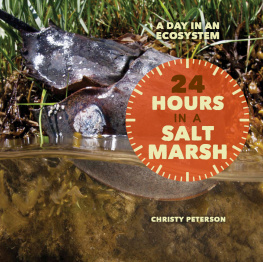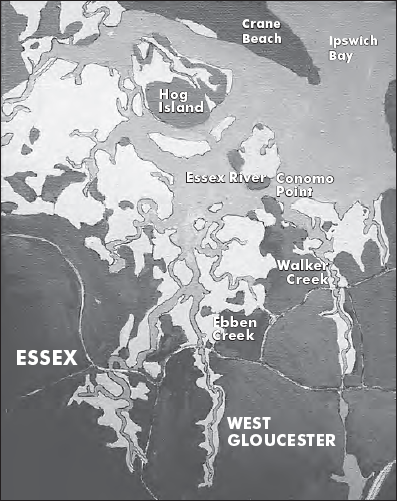Contents
Page List
Guide
PRAISE FOR
Swimming to the Top of the Tide
There is nothing quite so wonderful as slipping into a creek and letting it carry you upstream until the tide imperceptibly turns and carries you back out toward the ocean. It is doubly wonderful to discover someone who describes this experience with such love, lyricism, and scientific curiosity. Let Hanlon be your guide to this world.
William Sargent, author of The House on Ipswich Marsh and Plum Island: 4,000 Years on a Barrier Beach
Hanlon, in a year of swimming her way through marshes, across tidal rivers and sculpted granite quarries unique to Cape Ann, observes with a remarkably steady gaze all the world has to offerthe beauty and losses both. In clear, spare prose and fine-tuned observation, she takes you on a journey you wont soon forget.
Tim Traver, author of Sippewissett: Or, Life on a Salt Marsh and Fly Fishing and Conservation in Vermont
In her charming debut [Hanlon] turns the quotidian details of marriage and family life into a lyrical investigation of something bigger and more complex than oneself. Merging leisurely seaside adventure with ecological sensibilities, Hanlon delivers a lyrical ode to a changing environment.
Publishers Weekly
[Hanlon] is as skilled at demystifying complex scientific concepts as she is in portraying goldspangled waterline sunsets and muted winter compositions of marsh grasses. The whole is enriched with personal reflections on raising a family, aging, and the changing nature of marriage.
Foreword Reviews
SWIMMING TO THE TOP OF THE TIDE
SWIMMING TO THE TOP OF THE TIDE
Finding Life Where Land and Water Meet
Patricia Hanlon
First published in the United States in 2021
by Bellevue Literary Press, New York
For information, contact:
Bellevue Literary Press
90 Broad Street
Suite 2100
New York, NY 10004
www.blpress.org
2021 by Patricia Hanlon
Library of Congress Cataloging-in-Publication Data
Names: Hanlon, Patricia, author.
Title: Swimming to the top of the tide : finding life where land and water meet / Patricia Hanlon.
Description: First edition. | New York : Bellevue Literary Press, 2021. | Includes bibliographical references.
Identifiers: LCCN 2020035027 (print) | LCCN 2020035028 (ebook) | ISBN 9781942658870 (paperback) | ISBN 9781942658887 (epub)
Subjects: LCSH: Salt marsh ecologyNew England. | Marsh ecologyConservationNew England.
Classification: LCC QH104.5.N4 H36 2021 (print) | LCC QH104.5.N4 (ebook) | DDC 577.690974dc23
LC record available at https://lccn.loc.gov/2020035027
LC ebook record available at https://lccn.loc.gov/2020035028
All rights reserved. No part of this publication may be reproduced or transmitted in any form or by any means, electronic or mechanical, including photocopy, recording, or any information storage and retrieval system now known or to be invented, without permission in writing from the publisher, except by a reviewer who wishes to quote brief passages in connection with a print, online, or broadcast review.
Bellevue Literary Press would like to thank all its generous donorsindividuals and foundationsfor their support.
| This publication is made possible by the New York State Council on the Arts with the support of Governor Andrew M. Cuomo and the New York State Legislature. |
Book design and composition by Mulberry Tree Press, Inc.
Bellevue Literary Press is committed to ecological stewardship in our book production practices, working to reduce our impact on the natural environment.
 This book is printed on acid-free paper.
This book is printed on acid-free paper.
Manufactured in the United States of America.
First Edition
9 8 7 6 5 4 3 2 1
paperback ISBN: 978-1-942658-87-0
ebook ISBN: 978-1-942658-88-7
For our children and grandchildren
We shape the world by living.
Jedediah Purdy, After Nature:
A Politics for the Anthropocene
CONTENTS
SWIMMING TO THE TOP OF THE TIDE
LAND AND SEA: AN OVERTURE
W ith our extended family now scattered across five states, my husband, Robert, and I fly more often than we used to. If its a daytime flight, we book seats in consecutive rows, so were near each other but have our own window seats. If hes in the seat ahead, I talk to the edge of his face: the back of his ear, a bit of graying hair, the slight curve of an eyelash. If hes behind me and Ive gotten absorbed in some reading, I might feel a nudge (or vice versa).
Look, that nudge says. Something interesting down below.
Not so long ago, on a cloudless spring day, we flew back to Boston from Tampa. After crossing upper Florida, the plane followed the coast and we had the rare treat of watching a thousand-some miles of continental edgeall the way from Georgia to Massachusettsscroll by down below like a story.
Along the coast of Georgia and the Carolinas, that story unfolds at a leisurely pace. Rivers flow seaward. The sea, with its twice-daily tides, pushes back. Matter is shaken up and rearranged, but the whole thing stays more or less in balance, sustaining a permanently impermanent coastal band of thresholds facing both ways: watery land and landy water.
North of Charleston, South Carolina, there is a subtle change in the shape of the coastline. It begins to scallop, with the pointy parts, the spits and shoals, facing more dramatically seaward. Theres a pronounced swoop from Myrtle Beach to Frying Pan Shoals, in North Carolina, then another one beginning at the sand spit near Harkers Island, where the intertidal zone swells out into the Atlantic like a pregnant belly, forming the combined Pamlico and Albemarle Sounds.
Another shift occurs near Virginia Beach, where the continental-edge story begins happening on a more epic scale. The interfingerings of land and sea coalesce into much larger innies and outies, like the Chesapeake and Delaware Bays, separated by the Delmarva Peninsula.
The East Coast turns a corner at the slender barrier spit of Sandy Hook, near the New JerseyNew York state line. This is also where the Laurentide Ice Sheet halted twenty thousand years ago, before beginning its long retreat. From here on up, the coast shows the influence of glacial flow and ebb. The shoreline includes exposed bedrock, deep natural harbors, and large rivers reaching deeper inland. Just past Sandy Hook is the New JerseyNew York Harbor. Unlike the vast salt marshes of the South, the ones here are fewer and farther apart, tucked between rocky coasts and urban hardscape.
Toward the end of that flight, I must have nodded off, because when Robert nudged me, wed flown past Boston and were forty miles north of the city, in a holding pattern. At one mile above sea level instead of five, waves now unfurled, boats cut through the water, and cars slid like beads on the highways. While I hadnt been watching, the view out the window had become much more localour local, in fact. The plane banked, the porthole briefly framing a thousand-some acres of tidal estuary sheltered by the two barrier beaches we know well, Wingaersheek and Crane.
















 This book is printed on acid-free paper.
This book is printed on acid-free paper.